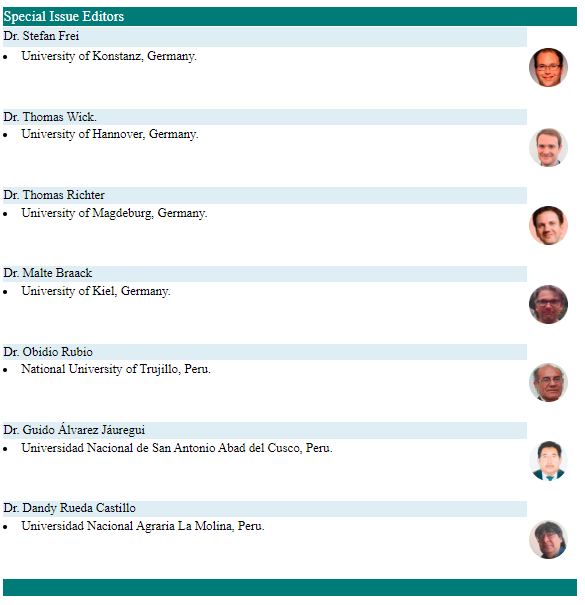Mathematical models for Zika with exposed variables and delay. Comparison and experimentation in Suriname and El Salvador
DOI:
https://doi.org/10.17268/sel.mat.2019.01.01Palavras-chave:
Ordinary differential equations, models, delay, transmission, ZIKVResumo
The Zika Virus (ZIKV) is a virus transmitted by Aedes aegypti mosquitoes (same as the one transmitting dengue and chikungunya fever). The main way of contagion by the ZIKV is caused by the bite of a mosquito that, after feeding from someone contaminated, can transport the virus throughout its life, transmitting the disease to a population that does not have the immunity. It can also be transmitted through a person’s sexual relationship with ZIKV to their partners, even if the infected person does not have the symptoms of the disease. In this work, we present two mathematical models for the Zika epidemic by using (1) ordinary differential equations and, (2) ordinary differential equations with temporal delay (discrete), which is the time it takes mosquitoes to develop the virus. We make a comparison between the two modeling variants. Computational simulations are performed for Suriname and El Salvador, which are countries that are prone to develop the epidemic in an endemic manner.
Referências
Alizon, S and Magnus, C. Modelling the course of an HIV infection: Insights from ecology and evolution, Viruses, 2: 1984-2013, 2012. ISSN: 1999-4915, DOI: 10.3390/v4101984.
Badshah, V. H., Porwal, P. and Tiwari, V. Mathematical modelling and role of dynamics in epidemiology, International Journal of Computational Science and Mathematics, 5(1): 4-10, 2013. ISSN: 0974-3189.
Baker, C. T. H., Paul, C. A. H. and Willé, D. R. Issues in the numerical solution of evolutionary delay differential equations, Adv. Comp. Math., 3: 171-196, 1995. DOI: 10.1016/S1474-6670(17)36928-8.ibitem, C.4 T. Berge, J. M. S. Lubuma,; . M. Moremedi, N. Morris and R. Kondera- Shava. A simple mathematical model for Ebola in Africa, Journal of Biological Dynamics, 11(1): 42-74, 2017. DO.1080/1 I: 10, 7513758.2016.1229817.
Bonyah, E. and Okosun, k. C. Mathematical modeling of Zika Virus, Asian Pacific Journal of Tropical Disease, 6 (9): 673-679, 2016. DOI: 0.1016/S2222-1808(16)61108.
Chicone, C. Ordinary differential equation with application, Springer Science and Business Media, 1999. ISBN: 0-387-30769-9.
Deepa, O. S., Nallamalli, S., Naikand, L. N. S., Teja, G. V. S. Mathematical model for transmission of Ebola, Procedia Computer Science, 48: 741-745, 2015. DOI: 10.1016/j.procs.2015.04.210.
Dick, G. W. A., Kitchen, S. F. and Haddow, A. J.. Zika Virus. I. Isolations and serogical specifity, Trans R Soc Trop Med Hyg, 46(5):509-520, 1952. DOI: 10.1016/0035-9203(52)90042-4.
Dick, G. W. A., Kitchen, S. F. and Haddow, A. J., irus , G. V. S. Pathogenicity and physical properties, Trans R Soc Trop Med Hyg, 46:521-534, 1952. DOI: 10.1016/0035-9203(52)90043-6.
Diekmam, O., Heesterbeek, J. A. P. and Roberts, M. G. The construction of next- generation matrices for compartimental epidemical models, J. Royal Society Interface, 7: 873-885, 2010. DOI: 10.1098/rsif.2009.0386.
Driver, R. D. Ordinary and Delay Differential Equations. New York: Springer Verlag, 1977. ISBN: 0-387-90231-7.
Esteva, L. and Vargas, C. Analysis of a Dengue disease transmission model, Mathematical Biosciences, 150: 131-151, 1998. DOI:10.1016/S0025-5564(98)10003-2.
Keeling, M. J. and Danon, L. Mathematical Modelling of infectious diseases, Brithsh Medical Bulletin, 92(1): 33-42, 2009. DOI:10.1093/bmb/ldp038.
Van den Driessche, P. and Watmough, J. Reproduction numbers and sub-threshold endemic equilibria for compartmental models of disease transmission, Mathematical Biosciences, 180: 29-48, 2002. DOI: 10.1016/S0025-5564(02)00108-6.
Mattheij, R. and Molenar, J. Ordinary differential equations in theory and practice, Published by Society for Industrial and Applied Mathematic, 2002. ISBN-13: 978-0898715316.
Oluyo, T. O. and Adeyemi, M. O. Mathematical analysis of Zika epidemic model, IOSR-JM, 12 (6): 21-33, 2017. ISSN: 2278-5728.
Tiemi, T. T., Maidan, N. A., Ferreira JR,W. C., Paulino, P. and Yang, H. Mathematical models for the aedes aegypti dispersal dynamics: Travelling waves by wing and wind, Bulletin of Mathematical Biology, 67: 509-528, 2005.
Shutt, D. P., Manore, C. A., Pankavich, S. Porter, A. T. and Del Valle, S. Y. Estimating the reproductive number, total outbreak size, and reporting rates for ZIKA epidemics in South and Central America, Epidemics, 21: 63-79, 2017. DOI: 10.1016/j.epidem.2017.06.005.
Supriatna, A. K., Soewono, E. and Vangils, S. A two-ages classes of Dengue transmission model, Math. Biosc., 216: 114-121, 2008. DOI:10.1016/j.mbs.2008.08.011.
Wordarz, D. and Nowak, M. A. Mathematical model of HIV pathogenesis and treatment, Bio ESSAYS, 24: 1178-1187, 2014. DOI:10.1002/bies.10196.
Downloads
Publicado
Como Citar
Edição
Seção
Licença
Os autores que publicam nesta revista aceitam as seguintes condições:
Os autores mantêm os direitos autorais e atribuem à revista o direito da primeira publicação, com o trabalho registrado com a licença de atribuição Creative Commons Atribución 4.0 Internacional (CC BY 4.0), que permite que terceiros usem o material publicado sempre que mencionarem a autoria do trabalho e os direitos autorais. Primeira publicação nesta revista.
Os autores podem fazer outros acordos contratuais independentes e adicionais para a distribuição não exclusiva da versão do artigo publicada nesta revista (por exemplo, incluí-la em um repositório institucional ou publicá-la em um livro), desde que afirme claramente que o trabalho Foi publicado nesta revista.
É permitido e recomendado aos autores que publiquem seus trabalhos na Internet (por exemplo, em páginas institucionais ou pessoais) antes e durante o processo de revisão e publicação, pois isso pode levar a trocas produtivas e a uma disseminação maior e mais rápida do trabalho. publicado (Consultar: efeito do acesso aberto).












